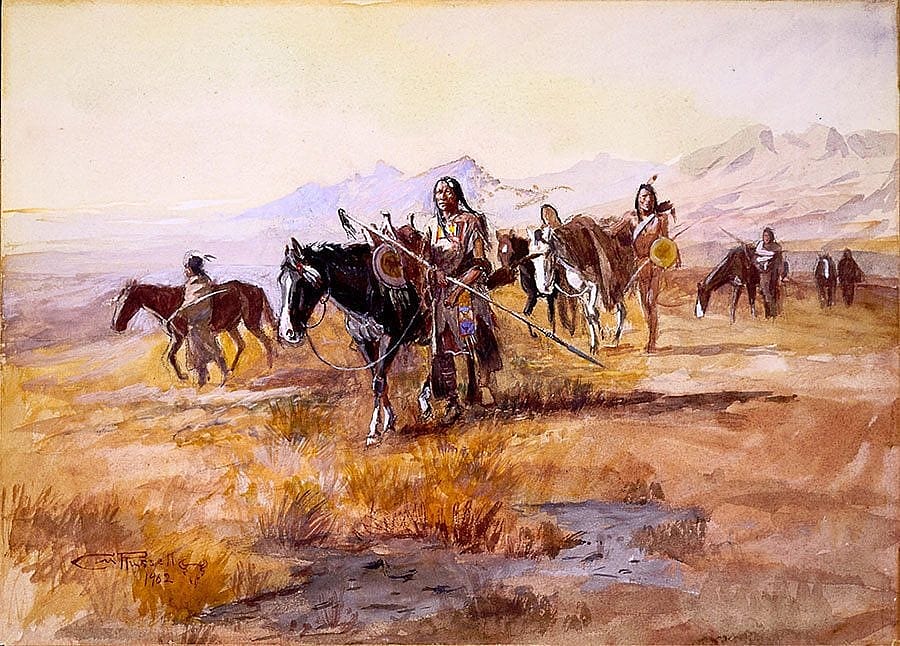
“Dangerous Ground” by Charles Marion Russell re-discovered – Points West Online
Originally published in Points West magazine
Fall 1994
“Dangerous Ground” by Charles Marion Russell re-discovered
 Sarah Laughlin
Sarah Laughlin
Former Curatorial Assistant, Whitney Western Art and Plains Indian museums
The “cowboy artist,” as Charles Marion Russell was known, frequently painted the horse culture of the West. Recently, while re-matting a work by Charles Russell titled Indians Walking Horses, we found an inscription on the back of the painting: Dangerous Ground. This title corresponds to that of a work Russell mentioned in a letter to George W. Kerr [1] of St. Louis. Russell described this painting in detail in his letter, explaining the meaning of the scene. The correlation between the painting and the letter ensures that this watercolor in the Historical Center’s collection is, in fact, Dangerous Ground, the location of which previously was unknown.
“I sent som pictures to Father one among them for you called dangerious ground it represents a Kootenai hunting party In the old buffao days the Kootenais who are a mountain tribe often invaded their enemys country for buffilo the Black feet live on the planes and are a verry strong warlike people who as the Indian would say had broken the pipe with the mountain pople and the grass had growen long in the trail betwen their fires so when the Kootenai hunted in the Blackfoot country cautiously dismounting and walking beside his pony when in high or open county on these occasions they went in small partys generly using dark Poneys if white the owner threw his robe over him they traveled verry slow allowing thure animels to grase now and then imitating as nere as possible the movments of a heard of old bulles all glittring orniments were hidden even the lance was carred point down for fere its flash in the sun might betray them…he knows that some far off butte holds a seminal who is as motionless as the rocks about him” [2]
The silhouette of a rider on a horse is unmistakable, even at a distance, so Russell portrayed the Indians walking when they traveled in dangerous country.

The Indian way of life was familiar to Russell because for some months in 1888 he lived close to the Bloods, a band of the Blackfeet. He often listened to stories of the old way of life, before the extermination of the bison. The Kootenai, a Plateau tribe that lived west of the Rockies, were enemies of the Blackfeet, so it is likely that Russell heard stories that contained such scenes as that depicted in Dangerous Ground. He preferred to portray Indian life in a world without Europeans, through the eyes of the native inhabitants.
This painting combines two elements that for Charlie Russell represented the true West. He had a great respect for Indians and their way of life, which he believed to be in harmony with nature. Russell also felt a great affinity for the horse; to him it represented the old way of life and the days he had spent as a cowboy. He disliked what the West had become—railroads, cars and fences were unwelcome intruders in the land he loved. For Russell the horse was the only mode of transportation worth riding or painting.
Notes
1. The letter belongs to collector Joseph S. Sample.
2. Brian W. Dippie, ed., Charles M. Russell. Word Painter: Letters 1887–1926 (Fort Worth: Amon Carter Museum, 1993), pp. 48–49.
Post 087
Written By
Nancy McClure
Nancy now does Grants & Foundations Relations for the Center of the West's Development Department, but was formerly the Content Producer for the Center's Public Relations Department, where her work included writing and updating website content, publicizing events, copy editing, working with images, and producing the e-newsletter Western Wire. Her current job is seeking and applying for funding from government grants and private foundations. In her spare time, Nancy enjoys photography, reading, flower gardening, and playing the flute.









